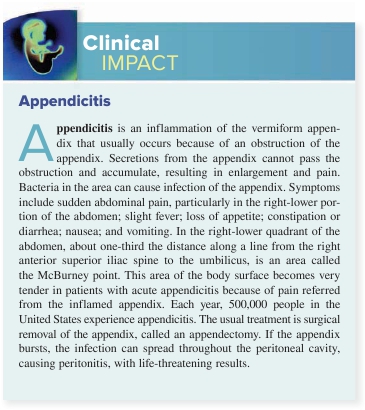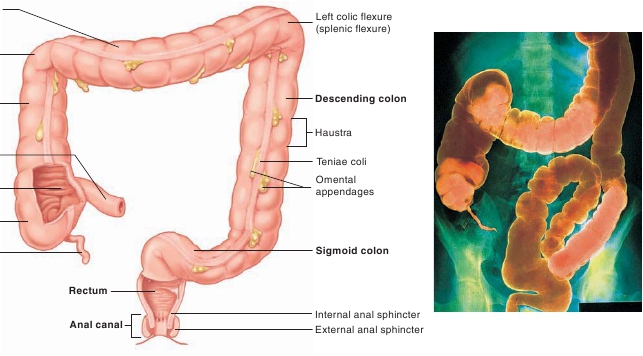904

PART 4 Regulation and Maintenance
chyme is converted to feces. The formation of feces involves theabsorption of water and salts, secretion of mucus, and extensiveaction of microorganisms. The colon stores the feces until theyare eliminated by defecation. About 1500 mL of chyme enter thececum each day, but more than 90% of the volume is reab-sorbed, so that only 80–150 mL of feces are normally eliminatedby defecation.
Anatomy of the Large Intestine
Cecum
The
cecum
(s ē ′k ŭ m) is the proximal end of the large intestine,where it meets the small intestine at the ileocecal junction. Thececum extends inferiorly about 6 cm past the ileocecal junctionin the form of a blind sac (figure 24.25). The
vermiform
(ver′mi-f ō rm; worm-shaped)
appendix
is a smaller, blind tubeabout 9 cm long attached to the cecum. The walls of the appen-dix contain many lymphatic nodules, which contribute toimmune functions.
Colon
The
colon
(k ō ′lon), about 1.5–1.8 m long, consists of four parts:the ascending colon, transverse colon, descending colon, andsigmoid colon (figure 24.25). The
ascending colon
extendssuperiorly from the cecum and ends at the right colic flexure(hepatic flexure) near the right inferior margin of the liver. The
transverse colon
extends from the right colic flexure to the leftcolic flexure (splenic flexure), and the
descending colon
Transverse colon
extends from the left colic flexure to the superior opening of thetrue pelvis, where it becomes the sigmoid colon. The
sigmoidcolon
forms an S-shaped tube that extends into the pelvis andends at the rectum.

Right colic flexure(hepatic flexure)
Ascendingcolon
Ileum
Ileocecalvalve
Cecum
Vermiformappendix
(b)
Anterior view
(a)
Anterior view
FIGURE 24.25
Large Intestine
(
a
) The large intestine consists of the cecum, colon, rectum, and anal canal. The teniae coli and omental appendages are along the length of the colon.(
b
) Radiograph of the large intestine following a barium enema.